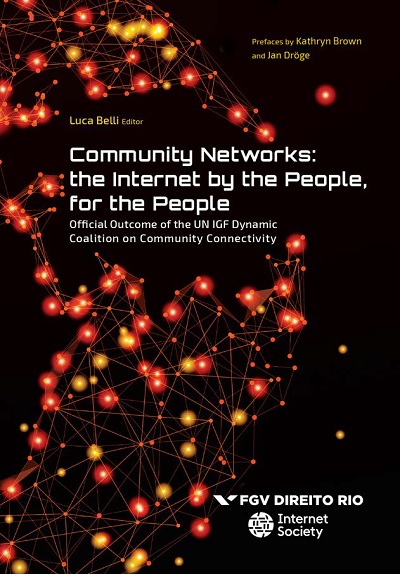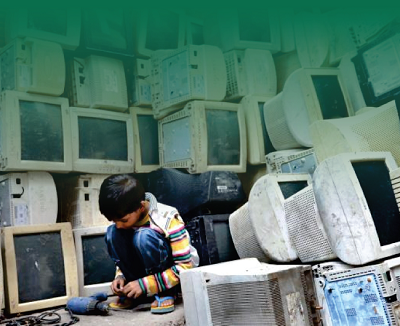The study, ‘Mobiles for Social and Behaviour Change analyses 14 mobile-based interventions into three broad categories – health, education, and civic participation. It further understands how mobile can be used as a communication tool for improving frontline workers lives.
Community Networks: Regulatory Issues and Gaps in India
This paper reflects views and opinions of community network providers who are trying to build their own low-cost and effective infrastructure for providing Internet connectivity. This document is part of a series of policy briefing papers, a collaborative effort between DEF & ISOC that address technological, content, sustainability, and organisational challenges, among others, which require further discussion in relevant national, regional and global policy fora.
A network by the community and for the community
The paper tries to understand Digital Empowerment Foundation (DEF)’s wireless for communities programme is one of the community wireless networks that is trying to provide affordable, ubiquitous and democratically controlled Internet access in rural regions of the country. The network enables for community economic development that can reduce poverty and encourage civic participation.
Policy Gaps and regulatory issues in the Indian experience on community networks
This document takes the Delhi, India-based Digital Empowerment Foundation’s (DEF) Wireless for Communities (W4C) model as a case study to understand the legal and regulatory challenges of spectrum allocation and management, licensing regulation, and bandwidth issues in developing countries. The first section of this document maps out the common elements of these challenges among community network providers, while the next section addresses the policy, legal, licensing, and bandwidth problems in India. This document investigates the efficacy of creating wireless community networks (WCNs), Rural Internet service providers (RISPs), or Community-based Internet Service Providers (C-ISPs), and explores the possibility of policies, which could help in creating widespread information infrastructure for the country to better connect the subcontinent.
The binary Language to unbind digital literacy for illiterate
The paper is to illustrate a coming of age approach of imparting digital literacy to rural populations of the country, where traditional literacy is still lagging and where knowledge of English—a language that dominates the world of the Internet both in terms of technology and content—is rare or weak. New Delhi-based non-profit organization Digital Empowerment Foundation (DEF) has designed and developed START, a digital and media literacy learning curriculum and toolkit. This toolkit has been designed for first-generation technology users living in rural, remote and tribal parts of the country.
Assessing, evaluating and mapping risks involved in the informal e-Waste sector in India
The paper compares the recycling process of the informal sector with the formal sector. The paper also attempts to highlight the health and environmental issues created by the informal sector. At last, it attempts to identify a mechanism to regulate the informal sector and how it will create job opportunities if it is regulated and integrated with the formal sector. This study aims to fill this knowledge gap by presenting findings from discussions with informal sector workers, highlighting the elements for scaling up learnings and initiatives of formal-informal integration.
Barefoot women wireless engineers creating socially viable community networks in India
In this paper, we define ‘new technologies’ as technologies that are a result of the innovation of older technologies and aim at transforming lives. These technologies are often considered as threatening and unfamiliar and are often viewed as ‘unacceptable’ especially for women. However, with new sustainable innovation, technology has become an empowering agent in the lives of women, especially rural women. The paper also highlights how women have specifically understood the importance of connectivity and are building their own network. This paper also focuses on Creating ‘Community Women Barefoot Engineers’ which would mean that learning and knowledge are transferred and exchanged as women are empowered to act in a predominantly male society and venture into areas that were previously restricted for them.
Click here to download the report
Published at: OAsis, COL’s Open Access Repository
http://oasis.col.org/bitstream/handle/11599/3439/PCF9_Papers_paper_200.pdf?sequence=1&isAllowed=y
India’s most watched YouTube Channel
Last year, YouTube completed its 10th year in India crossing more than 225 million monthly active users. In the 10 years of its existence, Google owned video platform has penetrated 80 percent of India’s internet universe. In different categories of channels – music, entertainment and politics still hold the top most watched channels. Since 2008, the market of YouTube content has been changed drastically. According to Rajan Anandan, VP South East Asia, and India, Google, by 2020, India will have 650 million Internet users at current growth rate over 500 million unique users.
We analysed 1000 popular YouTube channels in 18 different categories, including music, entertainment, news & politics, comedy, education, science & technology, etc. Music category has the highest number of subscribers with 340.67 million followed by entertainment and news & politics with 226.17 and 111.94 million subscribers respectively. Whereas gaming, pets and animals and travel & events are the lowest categories with 2.73 million, 4.14 million and 5.01 million subscribers.
With affordable data plans, increasing penetration of smartphones along with a variety of content on YouTube, the video platform now reaches 85 percent of all highly engaged Internet users, in the 18 years and above age group in India. Analyzing further 174 YouTube under ‘Society’ category, which comprise of NGO, CSR (Corporate Social Responsibility), governmental, politics and educational related channels.
Only 5 organisational YouTube Channels under CSR sub-category have the highest number of subscribers. These organisations are analysed on based on subscribers, number of videos are uploaded and the total number of viewers. Interestingly, two of the philanthropic organisations are Reliance group.
Out of 26 NGOs, spiritual organisations – IRC TV, Isha Foundation, BAPSChannel and Gurudev Sri Sri Ravi Shankar have highest number of subscribers. Bilateral agencies like Save the Children, UNICEF India and British Council India have the highest number of subscribers after religious channels.
| YouTube statistics in India – NGO | |||
| Organisations | Subscribers | Videos uploaded | Total uploaded video views |
| IRC TV | 1475142 | 23241 | 300041024 |
| Isha Foundation | 661651 | 790 | 73160128 |
| BAPSChannel | 157034 | 2771 | 68236545 |
| Gurudev Sri Sri Ravi Shankar | 466478 | 1332 | 58139614 |
| Save the Children India | 87322 | 262 | 26641712 |
| UNICEF India | 18378 | 461 | 6636488 |
| British Council India | 57619 | 764 | 3912669 |
| HelpAge India | 8448 | 174 | 1587701 |
| TeachForIndia | 8267 | 179 | 1216930 |
| TERI | 5090 | 975 | 943589 |
| AYUSH Adivasi Yuva Shakti | 2233 | 182 | 657924 |
| Greenpeace India | 2356 | 272 | 545548 |
| SOS Children’s Villages India | 708 | 61 | 515656 |
| JoinHandsForChange | 348 | 37 | 433383 |
| Infosys BPM | 735 | 55 | 266297 |
| Infosys Finacle | 2380 | 131 | 140578 |
| Amnesty International India | 1305 | 163 | 137159 |
| savethechildrenind | 85 | 67 | 26581 |
| Buzz India | 127 | 54 | 25715 |
| WorldVisionIndia | 140 | 3 | 9896 |
| The Story Of | 0 | 20 | 8528 |
| Infosys InStep | 153 | 2 | 7602 |
| Infosys Consulting | 89 | 34 | 6285 |
| Infosys Foundation | 122 | 30 | 5914 |
| KHUSHII NGO | 28 | 3 | 687 |
| SmilingStart | 2 | 3 | 283 |
Similarly, out of 24 channels of political party and people, BJP, Narendra Modi and India National Congress have the highest number of total uploaded video views. There are also YouTube channels like ‘I Support Narendra Modi’, ‘CMO Gujarat’, ‘With Congress’ and ‘Namma Congress’ are also in list of most watched YouTube Channels, even though number of videos are lesser in number than others.
In India, YouTube is seeing incredible growth across all age groups, even amongst 55+ audience our reach stands at over 80%. It represents an incredible opportunity for brands to use that Intent to connect with their audience in a meaningful way and drive significant business results.
Status of disabled persons in India
Status of disabled persons in India
Since 1992, 3 December know as International Day of Persons with Disabilities (IDPD) around the world. As per world report on disability (WRD) 2011, more than 100 crore persons have some form of disability in the world, which translate to about 15 per cent of the world’s population.
Disability status in India
In India, about 2.68 crore persons are disabled which is 2.21 per cent of the total Indian population as per Census of India, 2011. Out of total disable persons 1.50 (56%) crore are males and 1.18 (44%) crore are females. State wise share of disabled persons illustrated in the figure below.
The above figure clearly indicating that Uttar Pradesh has the highest number of disabled persons (16.50% of the total disabled in the Country) followed by Maharashtra (11.05%). States like Gujrat, Tamil Nadu, Odisha and Karnataka disable percentage ranging between 4 to 5 per cent.
Disability among children
Above figure 2 shows the disability share (%) among children (0-6 years), it shows that Uttar Pradesh, Bihar, Maharashtra and West Bengal together contribute more than 50% of the disabled children (0-6 years) in the county. All top 10 states listed above constitute more than 80 per cent share of disabled children in India.
Working status of disable persons
Out of total disable persons 36.34 per cent disables are working in India, figure 3 shows the state wise working status of disabled persons. Nearly 50% of the disabled population reported as ‘workers’ in the states of Nagaland and Sikkim, which is the highest among all states. Whereas, states like Lakshadweep, Kerala and Delhi ranked at bottom respectively. The state with a highest disabled population (Uttar Pradesh) engaging only 34.79 per cent of the disabled population of the state, which is below to national percentage.
Literacy status
Figure 4 shows the literacy status of disable persons in India, it shows that Kerala and Goa have the highest literacy rate among the disabled persons (70%) and another side Arunachal Pradesh (38.75%) and Rajasthan (40.16%) reported with lowest literacy rate.

















